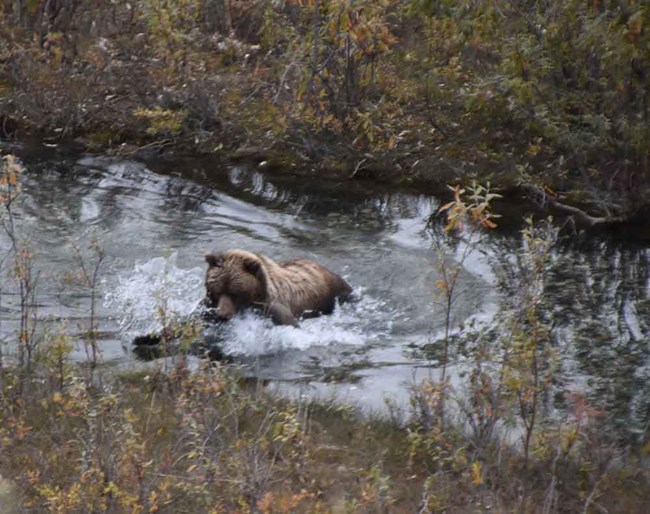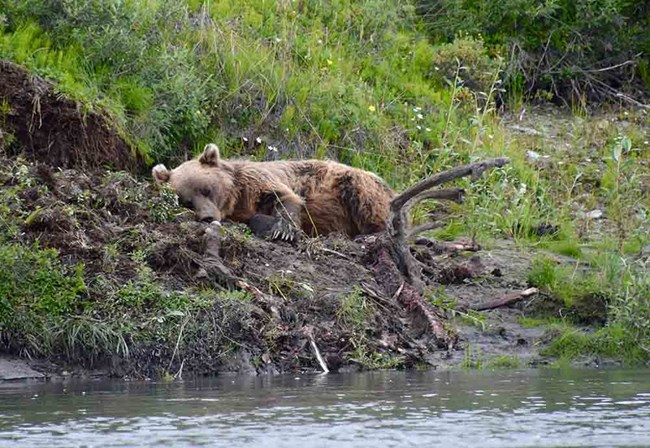Last updated: June 3, 2020
Article
The Surprising Diets of Brooks Range Brown Bears

NPS/Mat Sorum
What do brown bears eat when they live in the northern-most mountains of Alaska? Despite the apparent simplicity of this question, it had never been answered. Since they live far from the coast, it was assumed that bears in the mountains of Gates of the Arctic National Park and Preserve mainly ate vegetation (such as grasses and berries) and terrestrial meat (ground squirrels and moose, for example). To answer the question, and many others, NPS biologists teamed up with other researchers from 2014-2017 to study these brown bears. One thing they collected from each bear was a bit of hair that was later analyzed with a technique called stable isotope analysis. Stable isotope analysis detects elements such as carbon and nitrogen, which are used to trace the flow of nutrients through food webs, including food sources from the ocean or land. The hair analysis allowed the research team to determine the diet of individual bears during the period of hair growth (July-October). This time overlaps with hyperphagia, a period when bears eat as much as they can, regain weight lost the previous winter, and prepare for their long hibernation.

NPS/Matt Cameron
The results of the isotope analysis indicated that during late summer and early fall, male bears consumed more meat (~62% of their diet) than females (~40% of their diet). Somewhat surprisingly, the meat the bears were eating wasn’t entirely terrestrial, some of it was coming from the ocean over 250 miles away. They were eating salmon! What really surprised the research team was how much salmon these bears were eating: over 85% of the meat male bears ate came from salmon and over 75% for females. Male bears tend to be larger than females and also are known to kill cubs; males are probably dominating good fishing areas and thus consuming more salmon than females.
Once the team knew bears were eating salmon, they wanted to know whether salmon-eating bears were in better condition than vegetation-eating bears. Contrary to expectations, the amount of salmon bears ate did not affect how fat individuals were. The research team suspects that while brown bears as a population are generalists feeders, individuals can be dietary specialists and still acquire the necessary nutrients in a given year. Additionally, bears reduce the chance of conflict with other bears if they use diverse food sources and make use of all the nutritional resources available to them in the Gates of the Arctic ecosystem. So the question: What do bears eat in the interior Arctic, hundreds of miles from the coast? Turns out to be more interesting than expected.
Dietary plasticity and the importance of salmon to brown bear (Ursus arctos) body size and condition in a low Arctic ecosystem
Abstract
Ecological flexibility within animal populations can allow for variation in resource use and foraging decisions. We estimated brown bear (Ursus arctos) diet composition in Gates of the Arctic National Park and Preserve, Alaska from 2013 to 2015 to evaluate how variation in foraging behavior influences body condition and size. We used stable carbon (δ13C) and nitrogen (δ15N) isotope analyses of sectioned brown bear hair samples to evaluate assimilated diet. We then developed a set of a priori linear models to evaluate differences in the diet composition of brown bears (n = 80) in relation to body fat (%) and mass. The proportion of meat (salmon [Oncorhynchus keta] and terrestrial meat combined) in the diet from July through late September varied between male and female bears, with males (x−x− = 62%, SD = 30) assimilating significantly more meat than females (x−x− = 40%, SD = 29). Most of the meat consumed came from marine-derived resources for males (53% of the total diet or 86% of the meat) and females (31% of the total diet or 77% of the meat). As we found the range of observed diets was unrelated to physiological outcomes (i.e., percentage body fat), we suggest that ecological flexibility within populations may provide an adaptive advantage by allowing individuals to reduce competition with conspecifics by foraging on alternate food resources. Identifying variable foraging behaviors within a population can allow for a better understanding of complex behaviors and, ultimately, lead to more informed management decisions related to habitat use, development, and harvest.
Mangipane, L. S., D. J. R. Lafferty, K. Joly, M. S. Sorum, M. D. Cameron, J. L. Belant, G. V. Hilderbrand, and D. D. Gustine. 2020. Dietary plasticity and the importance of salmon to brown bear (Ursus arctos) body size and condition in a low Arctic ecosystem. Polar Biology.
